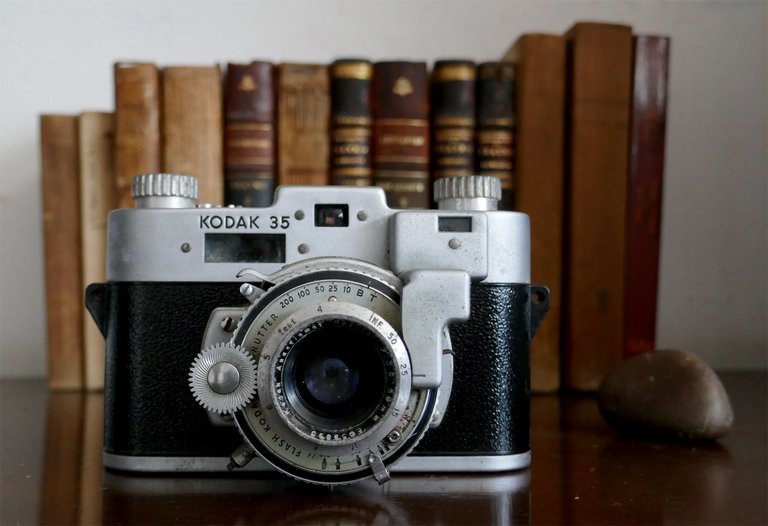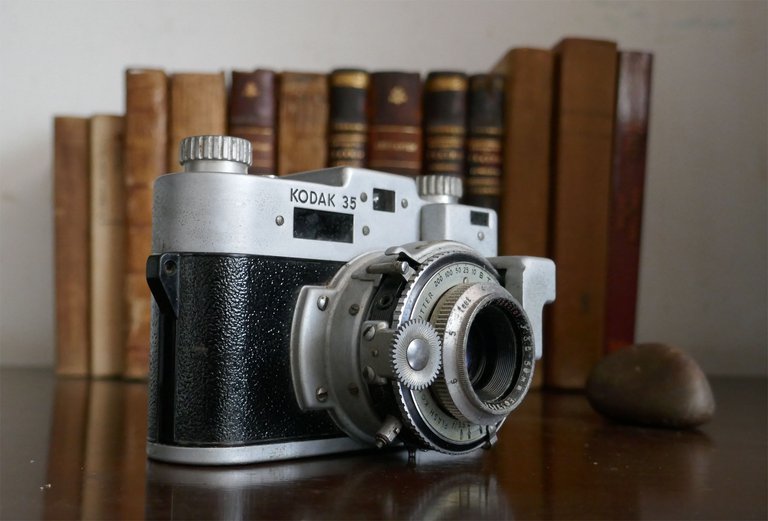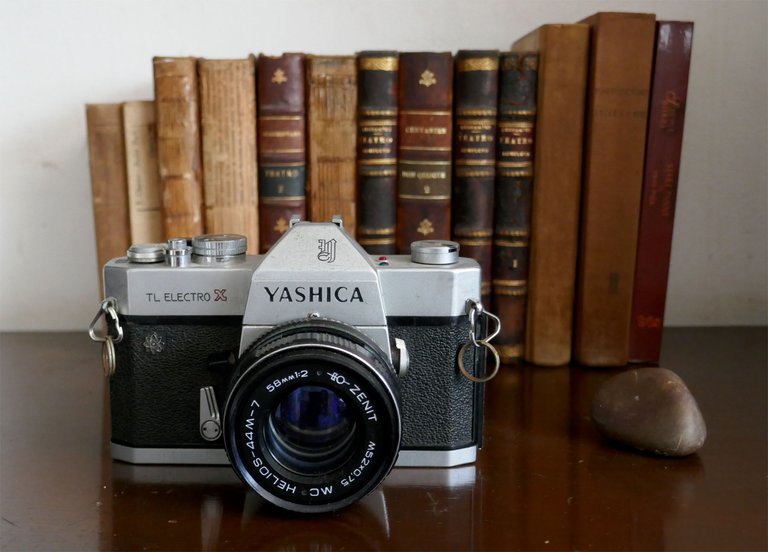7 vintage cameras you should know 🇬🇧 🇪🇸

(Brunet, 2024)
As you already know from other posts, I like to collect these cameras, which are little gems that have managed to stand the test of time. They have beautiful designs that captivate even the new generations that were born in the midst of digital technology.
They are authentic photographic relics that are still beating today. For this reason, today I would like to share with you 7 other cameras from my collection.
Agfa Super Silette:

This camera from the prestigious German brand Agfa, was created in Munich in 1955. It was given to my mother on one of her trips to Europe.
It is the super version of the Agfa Silette by incorporating a rangefinder.
It uses 35mm film and several versions were made. The high-end version comes with a Synchro-Compur lock and an optic consisting of several Agfa Solagon lenses.

Canon AE-1:

This 35mm reflex camera was manufactured in Japan by the prestigious brand Canon in 1976. For all photography lovers, it is one of the most used brands, being this model, a well appreciated reference.
It was a gift from a patient I had during my year of medical residency. He was a professional photographer and had it repeated among his variety of cameras.
It was the first generation to use microprocessor technology, and one of the most successful cameras sold worldwide.

Fujica STX-1:

Another Japanese gem, a 35mm SLR, manufactured by Fuji in the late 70s. I bought it near my home, from a photographer who likes to collect them.
Its operation is manual, with no program modes. However, it needs a battery to operate its light meter.

Kodak 35 Rangefinder:

This camera has a design that I love, it is distinctive and shows a very strong construction. I found it on a table, next to other antique items being offered by a book seller. I couldn't resist passing it up.
The Kodak 35 was manufactured in USA in 1938, by the Eastman Kodak Company, being their first 35mm camera. The Kodak 35 Rangefinder was its improved version with changes in its external design: film counter, fixed external viewfinder, two knobs for winding and rewinding. It also incorporated a rangefinder with a separate window.


Nikon FM:

This camera was a gift from a colleague, who gave it to me as a present before emigrating. Another of the flagship Japanese brands, used by most photographers.
The Nikon FM came on the market in 1977, it uses 35mm film and its manual operation is practical and simple. It comes with a photometer that works through a battery.

YASHICA TL electro X:


This other 35mm SLR camera was sold to me by the same photographer who offered me the Fujica camera mentioned above.
It was manufactured in 1968, in Japan. Its mount is M42, widely used by other brands. That way we can attach to it a varied availability of lenses.
It is a model with advanced electronics: microchip, electric photometer, lights in the viewfinder for exposure, and mechanical shutter with electronic timing.

Kodak Brownie Holiday:

Unlike the previous cameras made of metal, this model has its body made of brown bakelite. This makes it lighter, but maintains its durability as it is a thermosetting synthetic polymer.
In the upper part it has a flattened strap of the same color, which adds to give that vintage look to its design.
This model was manufactured in 1955, in Rochester, north of New York. It uses a Dakon lens, has a rotary lock and uses 127mm film.
It is protected in that yellow cardboard packaging that gives it shelter. I bought it at a flea market, on one of my trips to the great American city.

Each of these analog cameras holds years of stories and anecdotes in their mechanical bodies. They were the cameras in which many people took their first steps to lay the foundations of photography. They are vintage objects that awaken the interest of new generations, increasing their demand.
Of those presented today, Canon along with Nikon, are the most used camera brands to immortalize in photos, those beautiful moments and stories that resonate every day in our emotions.
I hope you liked the post. Have a nice Monday.
7 cámaras vintage que debes conocer

(Brunet, 2024)
Como conocen de otros posts, me gusta coleccionar estas cámaras, que son pequeñas joyas que han sabido resistir el paso del tiempo. Tienen unos diseños preciosos que cautivan incluso a las nuevas generaciones que nacieron en plena era de la tecnología digital.
Son auténticas reliquias fotográficas que siguen latiendo hoy en día. Por este motivo, hoy quiero compartir con vosotros otras 7 cámaras de mi colección.
Agfa Super Silette:

Esta cámara de la prestigiosa marca alemana Agfa, fue creada en Múnich en 1955. Se la regalaron a mi madre en uno de sus viajes a Europa.
Es la versión super de la Agfa Silette al incorporar un telémetro.
Utiliza película de 35mm y se hicieron varias versiones. La versión de gama alta viene con un bloqueo Synchro-Compur y una óptica formada por varias lentes Agfa Solagon.

Canon AE-1:

Esta cámara réflex de 35mm fue fabricada en Japón por la prestigiosa marca Canon en 1976. Para todos los amantes de la fotografía, es una de las marcas más utilizadas, siendo este modelo, una referencia muy apreciada.
Fue un regalo de un paciente que tuve durante mi año de residencia médica. Era fotógrafo profesional y la tenía repetida entre su variedad de cámaras.
Fue la primera generación en utilizar la tecnología de microprocesador, y una de las cámaras más exitosas vendidas en todo el mundo.

Fujica STX-1:

Otra joya japonesa, una réflex de 35mm, fabricada por Fuji a finales de los 70. La compré cerca de mi casa, a un fotógrafo aficionado a coleccionarlas.
Su funcionamiento es manual, sin modos de programa. Sin embargo, necesita una batería para hacer funcionar su medidor de luz.

Kodak 35 Rangefinder:

Esta cámara tiene un diseño que me encanta, es distintiva y muestra una construcción muy sólida. La encontré en una mesa, junto a otros objetos antiguos que ofrecía un vendedor de libros. No pude resistirme a dejarla pasar.
La Kodak 35 fue fabricada en USA en 1938, por la Eastman Kodak Company, siendo su primera cámara de 35mm. La Kodak 35 Rangefinder fue su versión mejorada con cambios en su diseño externo: contador de películas, visor externo fijo, dos mandos para el bobinado y rebobinado. También incorporaba un telémetro con ventana independiente.


Nikon FM:

Esta cámara fue un regalo de un colega, que me la obsequió antes de emigrar. Otra de las marcas emblemáticas japonesas, utilizada por la mayoría de los fotógrafos.
La Nikon FM salió al mercado en 1977, utiliza película de 35mm y su manejo manual es práctico y sencillo. Viene con un fotómetro que funciona a través de una batería.

YASHICA TL electro X:


Esta otra cámara réflex de 35 mm me la vendió el mismo fotógrafo que me ofreció la cámara Fujica mencionada anteriormente.
Fue fabricada en 1968, en Japón. Su montura es M42, muy utilizada por otras marcas. Así podemos acoplarle una variada disponibilidad de objetivos.
Es un modelo con electrónica avanzada: microchip, fotómetro eléctrico, luces en el visor para la exposición, y obturador mecánico con temporización electrónica.

Kodak Brownie Holiday:

A diferencia de las cámaras anteriores fabricadas en metal, este modelo tiene el cuerpo hecho de baquelita color marrón. Esto la hace más ligera, pero mantiene su durabilidad al tratarse de un polímero sintético termoestable.
En la parte superior tiene una correa plana del mismo color, que contribuye a dar ese aspecto vintage a su diseño.
Este modelo fue fabricado en 1955, en Rochester, al norte de Nueva York. Utiliza un objetivo Dakon, tiene cierre giratorio y usa película de 127mm.
Está protegido en ese embalaje de cartón amarillo que le da cobijo. Lo compré en un mercado de pulgas, en uno de mis viajes a la gran ciudad americana.

Cada una de estas cámaras analógicas guarda años de historias y anécdotas en sus cuerpos mecánicos. Fueron las cámaras con las que muchas personas dieron sus primeros pasos para sentar las bases de la fotografía. Son objetos vintage que despiertan el interés de las nuevas generaciones, aumentando su demanda.
De las presentadas hoy, Canon junto con Nikon, son las marcas de cámaras más utilizadas para inmortalizar en fotos, esos bellos momentos e historias que resuenan cada día en nuestras emociones.
Espero que les haya gustado el post. Que tengan un buen día de lunes.

Own photos. Camera: Panasonic Lumix model DMC-ZS100
Text divider. Free use from @eve66
Text by Andrés Brunet
@abrunet

Thank you for reading / Gracias por leer
Welcome your comments / Bienvenidos sus comentarios
Infinite greetings! / ¡Saludos infinitos!
How beautiful, you brought back memories of my childhood when my grandmother would take one of these cameras and photograph us all over the garden of my house ❤️
These cameras are a beauty and mark the history of photography, you have a nice collection, each one with its own history ❤️ They have many moments recorded in their rolls.
Hi. It is part of the magic of photography. These cameras, now vintage, were used by our parents and relatives to remind us today, moments of our childhood, of the places we shared.
As you say: in those rolls there are many experiences and stories. I'm glad you liked to see part of my collection. I had previously written 3 posts on the subject, and you can search to see other models of these cameras. Thanks for writing. Regards
Excellent your publication, as a child I always liked this kind of cameras, all of them have a historical and sentimental value. Here in Venezuela it is very difficult, if not impossible, to find the rolls of film to load these historic cameras, and if you find any the price is very high. Preference is given to digital files in the photo stores because it is easier to take pictures with your cell phone. I have a digital camera and that is what I use to take pictures on special occasions, although I still miss the technology of the old cameras.
Hi. I understand what you are saying. Finding rolls of film for these analog cameras is more complicated and expensive. It is more difficult than buying a vinyl record, which also cost more than compact discs. Everything vintage is in demand and still cameras is one of the key niches. Thanks for writing. Regards
So awesome. I have a Nikon F1
Thanks
Todas unas joyas, te gustan muchos las camaras, creo que en mi casa solo hemos tenido dos camaras y ya😆
Hola. Me gustan las cámaras analógicas vintage porque se fabricaban para perdurar en el tiempo, y gracias a ellas, podemos conocer parte de la historia. Mis saludos